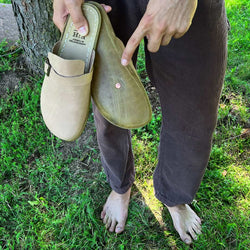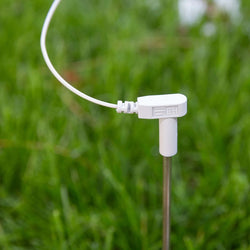Table Of Contents
Introduction to Earthing
The concept of 'Earthing', also known as 'Grounding', refers to the practice of connecting with the Earth's surface electrons by walking barefoot outside or sitting, working, or sleeping indoors connected to conductive systems that transfer the Earth's electrons from the ground into the body.
This ancient and fundamental practice has been part of human tradition and survival since time immemorial, only recently rediscovered in the realm of modern science as having numerous health benefits. It is the inherent natural electric charge of our planet that is at play here, a timeless asset that has been utilized knowingly or unknowingly for healing by various cultures throughout history.
Historical Context of Earthing
Throughout human history, civilizations have instinctively recognized the Earth's nurturing and restorative powers. The act of walking barefoot, utilizing animal hides for footwear and bedding, and the simple act of sitting or lying on the ground have served as conduits for the transfer of the Earth’s energy into the human body. This section explores how different cultures across time have integrated this natural law of Earth's healing electric charge into their customs and healing practices.
Ancient Practices and Philosophies
In ancient China, the principle of Qi (pronounced "chee") was central to their understanding of the universe. Qi represents the vital life force or energy that fills the universe, with Heaven Qi comprising the forces exerted on Earth by celestial bodies, and Earth Qi encompassing the energy lines and patterns, magnetic field, and geothermal energy of the Earth. The concept of Qi encapsulates the importance of the cycles of Earth and celestial energies in the growth and health of all living things. Walking barefoot and engaging in grounding exercises like yoga, tai chi, and qigong without footwear is a reflection of these beliefs, as these activities allow for the absorption of Earth Qi.
Naturopathy and Earth Power
Fast forward to the late 19th century in Germany, where the natural health movement saw figures like Adolf Just, a founder of naturopathy, emphasize the importance of direct contact with the Earth. His teachings and practices, which included walking barefoot and sleeping on the ground, highlighted what he termed "Earth power." Just compared the human feet to roots of plants, drawing vital energy and strength out of the Earth. His ideas gained international traction, inspiring similar movements in the United States and beyond.
Indigenous Wisdom
Native American traditions, particularly, have held a deep respect for the Earth's significance. Figures like Ota Kte (Luther Standing Bear) of the Lakota Sioux expressed this connection eloquently, noting the love his people had for the soil and the healing and strengthening it provided. The grounding practices of indigenous peoples were not merely physical but also held profound spiritual significance.Expanding the History of Earthing
Electrotherapy and Biophysics
The exploration of the Earth's electricity for therapeutic purposes dates back to the 18th and 19th centuries with the advent of electrotherapy. Pioneers in this field experimented with electric currents to alleviate pain and treat various ailments, suggesting an early recognition of the body's electrical nature and its potential for healing.
Anthropological Findings
Anthropological studies have uncovered numerous practices among indigenous cultures that suggest a form of Earthing. Rituals that involve direct contact with the Earth, like ceremonial dances and healing practices, indicate a profound understanding of grounding that predates modern scientific discovery.
Environmental Medicine
In the broader scope of environmental medicine, the disconnect between modern lifestyles and natural elements has been scrutinized. This field investigates how modern disconnection from the Earth may contribute to various health issues, supporting the notion that reconnection through grounding could offer significant health benefits.
Global Healing Traditions
Many healing traditions around the world, such as Ayurveda, promote practices similar to Earthing. Ayurvedic medicine, for example, advises walking on grass during the early morning to harness the Earth's dew-covered energy for balancing the body's doshas.
Modern Wellness and Technology
In contemporary wellness movements, there's a resurgence of interest in Earthing, supported by the development of grounding technologies like mats and sheets. These tools are designed to reconnect individuals with the Earth's electrical field even while indoors, reflecting a modern adaptation of ancient wisdom.
Research in Biological Sciences
Biological and health sciences research, particularly into the human microbiome, suggests that the Earth's bacteria, which we contact through grounding, might play a role in regulating our immune system, offering potential pathways for healing and well-being.
Philosophical Integration
Philosophical and spiritual writings across various cultures have long hinted at the necessity of harmony with the Earth’s elements. Such texts often echo the holistic approach inherent in Earthing, reinforcing the belief that humans require a balanced exchange with the natural world for optimal health.
Cross-Cultural Comparisons
Studies comparing the health outcomes of populations with varying levels of contact with nature often find that those living closer to nature exhibit better health metrics. These comparative studies provide indirect support for the benefits of grounding practices, as they highlight the potential health disparities caused by modern disconnection from natural environments.
Scientific Journey of Earthing
Early Biophysical Research
The 1920s and 1930s marked a significant period where French biophysicists began to study the effects of grounding on the human body. Although details of their work are still being explored, their pioneering studies laid the groundwork for understanding how the Earth's electric potential could influence human physiology.
Electrical Engineering and Health
Clint Ober's contribution to Earthing science brought an engineering perspective to biological health. With his background in the cable TV industry, Ober applied his understanding of electrical grounding to the human body, hypothesizing that like electrical systems, the human body could also benefit from being grounded to the Earth. His subsequent experiments led to a surge of interest and research into the health implications of grounding.
Clinical Research and Observations
Ober's initial observations—improved sleep and reduced chronic pain through grounding—sparked a series of structured experiments and clinical studies. These studies have examined Earthing's impact on various health parameters, including inflammation, heart rate variability, and cortisol levels, providing evidence for significant physiological changes associated with grounding practices.
The Polish Studies
The work of Karol Sokal and his son Pawel Sokal in Poland further expanded the scientific understanding of grounding. Their research suggested that grounding might be a primary factor in regulating the endocrine and nervous systems, offering a new perspective on how Earthing can be integrated into medical practice.
Global Research Contributions
Earthing research has now become a global endeavor, with studies from around the world contributing to a growing body of evidence. These studies are investigating the potential of grounding to affect a wide range of modern ailments, including sleep disorders, chronic pain, and stress-related conditions.
Potential for Future Discoveries
As we continue to learn more about grounding, the frontier of Earthing research promises to unveil novel insights into how reconnecting with the Earth can enhance physiological functioning and promote health. It stands as an exciting field within environmental medicine and biophysics, with the potential to transform our understanding of health and healing.
Deepening the Scientific Understanding of Earthing
Biophysics and Electrophysiology
The relationship between the Earth's electromagnetic field and the human body's own electrical systems has been a subject of intrigue and study within biophysics and electrophysiology. The human body, being conductive in nature, is influenced by external electric, magnetic, and electromagnetic fields. Early biophysical research has indicated that the Earth's mild negative charge can help to stabilize the body's biological rhythms and reduce oxidative stress.
Electrical Engineering Meets Physiology
Clint Ober's insight into the similarity between electrical grounding in engineering and the human body's potential need for an electrical connection to the Earth spurred a novel area of research. Ober's work suggested that the body might accumulate a positive charge over time, which could be neutralized through grounding, akin to discharging built-up static electricity.
The Rise of Grounding in Clinical Research
Grounding's impact on health has been the subject of several clinical studies, which have measured objective changes in inflammation, immune response, wound healing, and blood viscosity. Some research has even suggested improvements in heart rate variability, a marker for stress and autonomic nervous system balance, following grounding interventions.
International Research Efforts
The findings from Poland by Karol Sokal and Pawel Sokal are part of a larger international research effort. Studies from various countries have been examining how grounding might influence the bioelectrical and biochemical aspects of the human body, suggesting that the Earth's electrical potential plays a role in the body's circadian rhythms and systemic balance.
Grounding and Sleep Physiology
Sleep studies have provided some of the most compelling data on the benefits of grounding. Research has indicated that individuals who practice grounding have improvements in various aspects of sleep, including reduced sleep disturbances, increased time spent in deep sleep, and overall better sleep quality.
Inflammation and Pain Management
One of the most significant areas of Earthing research involves inflammation, the body's natural response to injury and infection, but also a root cause of many chronic diseases. Grounding has been shown to reduce inflammation as evidenced by thermal imaging and blood chemistry markers of inflammation.
Emerging Perspectives in Environmental Medicine
Environmental medicine is increasingly acknowledging the impact of Earthing on human health, positing that our increasing disconnection from the Earth's surface may be a contributing factor to the rise of chronic disease. This field is beginning to explore grounding as a potentially vital element of an environmental health paradigm.
The Future of Earthing Research
The future of Earthing research holds the promise of further elucidating the mechanisms by which grounding influences the human body. As the scientific community continues to explore this connection, the integration of grounding practices in the prevention and management of disease could become a more widely recognized and recommended component of health care.
Practical Applications and Modern Integration of Earthing
Grounding in Daily Life
In our modern world, where lifestyles often limit our direct contact with the Earth, finding practical ways to integrate Earthing into daily life is becoming increasingly important. Grounding can be as simple as walking barefoot on natural surfaces like grass, sand, or soil. For those unable to spend time outdoors, grounding technology such as mats, bedding, and patches can simulate the effects of Earthing by connecting to the ground port of electrical outlets or directly to the Earth outside.
Earthing and Wellness Routines
Wellness routines that include Earthing practices are gaining popularity. Activities such as yoga, meditation, and mindfulness can be enhanced by performing them barefoot outdoors, connecting with the Earth to augment the benefits of these practices. Incorporating grounding into fitness routines is also a growing trend, with an emphasis on performing exercises on natural surfaces to promote balance and recovery.
Clinical Use of Grounding
Some healthcare practitioners have begun to include grounding as part of the therapeutic protocols for managing chronic inflammation, pain, and stress-related disorders. While still considered complementary, Earthing is gaining recognition for its potential to support conventional treatments, offering a non-invasive and natural adjunct therapy.
Research and Development of Grounding Devices
The development of grounding devices is an area of innovation, with new products being designed to provide the benefits of grounding in various settings, from personal homes to office spaces. Research into the efficacy and safety of these devices is ongoing, ensuring they effectively replicate the electrical conditions of natural grounding.
Education and Awareness
As research continues to validate the benefits of Earthing, educational efforts are important to increase awareness about the importance of staying connected to the Earth. Public health messages, wellness programs, and health care practitioners are starting to emphasize the simple, yet potentially profound, health benefits of grounding.
Environmental and Urban Planning
Urban and environmental planning can also integrate Earthing principles by creating green spaces that encourage direct contact with the Earth, such as parks, community gardens, and natural pathways. These initiatives not only enhance community well-being but also ensure that even urban environments provide opportunities for grounding.
The Role of Technology
While technology often contributes to our disconnection from the Earth, it can also play a role in reconnecting us. Apps that remind users to take outdoor breaks and footwear technology that incorporates conductive materials are examples of how innovation can foster greater connection with the Earth's healing energy.
Advancing Earthing Research and Practices
The future of Earthing lies in both advancing the scientific understanding and integrating grounding practices into daily life. As we continue to learn about the mechanisms and benefits of Earthing, it is likely that grounding will become an increasingly mainstream aspect of health and wellness.
Expanding Accessibility and Understanding of Earthing
Integrating Grounding in Public Health Initiatives
The potential public health benefits of Earthing could be profound. Public health initiatives can incorporate education about grounding into wellness campaigns, emphasizing its accessibility as a complementary health practice. These initiatives can drive home the message that simple, intentional contact with the Earth may have wide-ranging health benefits, such as reducing stress and promoting overall wellness.
Enhancing Psychological Well-being
The mental health benefits of Earthing, while less quantifiable, are becoming increasingly recognized. The calming and grounding effects of connecting with the Earth can enhance mindfulness practices, potentially reducing symptoms of anxiety and depression. Mental health professionals might consider recommending Earthing as a part of a holistic approach to emotional well-being.
Earthing in Work Environments
As we spend a significant portion of our lives at work, integrating Earthing practices in the workplace could contribute to better employee health and increased productivity. Employers can create workspaces with access to natural elements, encourage breaks that allow employees to walk outside, or even install grounding mats in areas where employees spend long periods sitting or standing.
Supporting Chronic Disease Management
For individuals dealing with chronic diseases, grounding may offer a supportive role in managing symptoms and improving quality of life. As part of a comprehensive management plan, grounding techniques could potentially mitigate some of the inflammatory processes associated with chronic diseases, a subject that warrants further research and clinical trials.
Building Community Around Earthing
Communities can come together to create shared spaces designed with grounding in mind, such as communal gardens or barefoot paths. Workshops, group activities, and community-based programs that focus on reconnecting with the Earth can foster a sense of unity and collective well-being.
Innovative Research Approaches
Moving forward, innovative research methods are needed to further understand the full spectrum of Earthing's benefits. Long-term studies, cross-disciplinary approaches, and integrative health research can provide deeper insights into how Earthing affects human health at various levels, from the cellular to the whole-body system.
Policy and Healthcare Integration
At the policy level, integrating Earthing into health guidelines and preventative care strategies could be a cost-effective way to support population health. Healthcare systems that embrace alternative and complementary therapies could include Earthing as part of patient education and preventative health measures.
Educational Programs and Curriculum
Education systems can include information about Earthing in curriculums related to health, science, and the environment. Teaching children and young adults about the importance of staying connected to the Earth can instill healthy habits early on and foster a lifelong appreciation for the natural world.







 Shoes
Shoes
 Boots
Boots
 Sandals
Sandals

 Shoes
Shoes
 Boots
Boots
 Sandals
Sandals

















